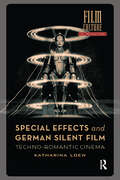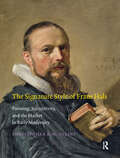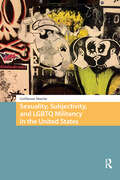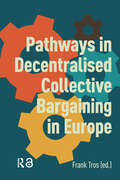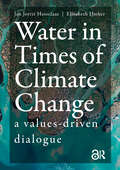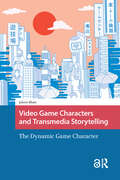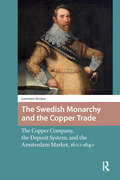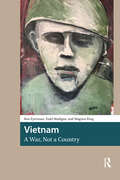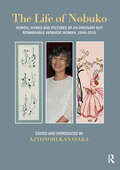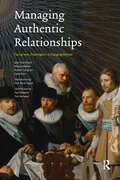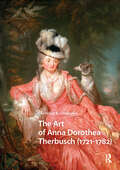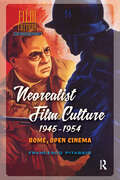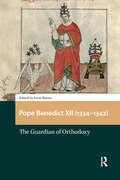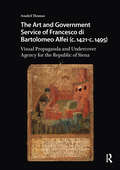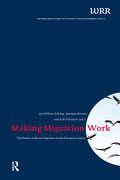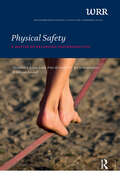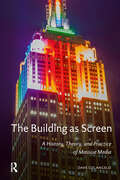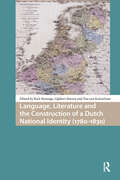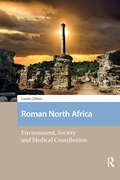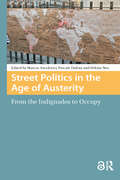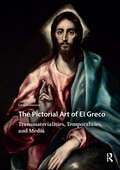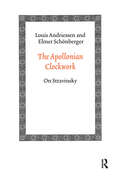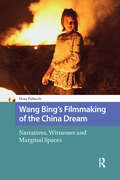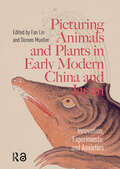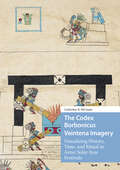- Table View
- List View
Special Effects and German Silent Film: Techno-Romantic Cinema (Film Culture in Transition)
by Katharina LoewIn recent decades, special effects have become a major new area of research in cinema studies. For the most part, they have been examined as spectacles or practical tools. In contrast, Special Effects and German Silent Film, foregrounds their function as an expressive device and their pivotal role in cinema’s emergence as a full-fledged art. Special effects not only shaped the look of iconic films like Nosferatu (1922) or Metropolis (1927), but they are central to a comprehensive understanding of German silent film culture writ large. This book examines special effects as the embodiment of a “techno-romantic” paradigm that seeks to harness technology – the epitome of modern materialism – as a means for accessing a spiritual realm. Employed to visualize ideas and emotions in a medium-specific way, special effects thus paved the way for film art.
The Signature Style of Frans Hals: Painting, Subjectivity, and the Market in Early Modernity (Amsterdam Studies in the Dutch Golden Age)
by Christopher D.M. AtkinsThis richly illustrated study is the first consider the manifold functions and meanings of Hals’s distinctive handling of paint. Atkins explores the uniqueness of Hals’s approach to painting and the relationship of his manner to seventeenth-century aesthetics. He also investigates the economic motivations and advantages of his methods, the operation of the style as a personal and workshop brand, and the apparent modernity of the artist’s style. The book seeks to understand the multiple levels on which Hals’s consciously cultivated manner of painting operated for himself, his pupils and assistants, his clients, and succeeding generations of viewers. As a result, the book offers a wholly new understanding of one of the leading artists of the Dutch Golden Age, and one of the most formative painters in the history of art in the Western tradition. It also provides a much needed interrogation of the interrelationships of subjectivity, style, authorship, methods of artistic and commercial production, economic consumption, and art theory in early modernity.
Sexuality, Subjectivity, and LGBTQ Militancy in the United States (Protest and Social Movements)
by Guillaume MarcheAs LGBTQ movements in Western Europe, North America, and other regions of the world are becoming increasingly successful at awarding LGBTQ people rights, especially institutional recognition for same-sex couples and their families, what becomes of the deeper social transformation that these movements initially aimed to achieve? The United States is in many ways a paradigmatic model for LGBTQ movements in other countries. Sexuality, Subjectivity, and LGBTQ Militancy in the United States focuses on the transformations of the US LGBTQ movement since the 1980s, highlighting the relationship between its institutionalization and the disappearance of sexuality from its most visible claims, so that its growing visibility and legitimation since the 1990s have paradoxically led to a decrease in grassroots militancy. The book examines the issue from the bottom up, identifying the links between the varying importance of sexuality as a movement theme and actors' mobilization, and enhances the import of subjectivity in militancy. It draws attention to cultural, sometimes infrapolitical, forms of militancy that perpetuate the role of sexuality in LGBTQ militancy.
Pathways in Decentralised Collective Bargaining in Europe
by Frank TrosOne of the main challenges in labour relations in Europe is the ongoing decentralisation of collective bargaining from national and sectoral levels to company levels. Decentralisation might be an answer to business needs in competitiveness and organisational flexibility. However, it risks erosion of collective bargaining structures, more inequality in employment conditions and fragmentation in trade unions' powers. Based on recent qualitative research, this book shows high varieties across European countries and economic sectors in degrees, forms and impacts of decentralisation. The authors explore, in interdisciplinary and multi-level perspectives, continuity and change in regulating and practicing collective bargaining in France, Germany, Ireland, Italy, the Netherlands, Poland, Spain and Sweden. In cross-country comparisons, company case studies in manufacturing and retail show the divergent effects of national regimes and social partners' power resources on trade unions' strategies and influence in company bargaining.
Water in Times of Climate Change: A Values-driven Dialogue
by Jan Jorrit Hasselaar Elisabeth IjmkerThis book on water and climate change goes beyond the usual and predictable analyses, by bringing religion and values into a discussion that is often dominated by technocratic solutions. The three case studies of Jakarta, Cape Town, and Amsterdam demonstrate the challenges of water management in urban areas and the role religion can play in addressing them. With representatives from science, politics, economics, and religion, as well as young voices, the book stimulates a values-driven dialogue on issues of water in times of climate change.
Video Game Characters and Transmedia Storytelling: The Dynamic Game Character (Games and Play)
by Joleen BlomCharacters are a vital aspect of today's transmedia practices. Combining theories on fictional persons from Japanese and Euro-American practices, this book discusses video game characters embedded in our popular media culture in which they are constantly produced and re-imagined. This book introduces the dynamic game character, a type of game character with a development structure that consists of multiple outcomes in a game. Through their actions and choices, players can influence these game characters' identities and affect their possible destinies. Games subvert the idea that fictional persons must maintain a coherent identity. This book shows that dynamic game characters challenge strategies of top-down control through close readings of the Mass Effect series, Persona 5, Hades, Animal Crossing: New Horizons and more. It is directed to all scholars interested in the topics of transmedia storytelling, video games, characters, and Japanese narratology.
The Swedish Monarchy and the Copper Trade: The Copper Company, the Deposit System, and the Amsterdam Market, 1600-1640 (Entanglements, Interactions, and Economies in the Early Modern World)
by Lawrence StrykerIn 1611, the seventeen-year-old Gustav Adolf ascended the throne of Sweden. Before the new king could sit on his throne, however, he faced a disastrous war against Denmark, another conflict in Russia, and a rebellious nobility at home. Plus, Sweden itself had an arctic climate and a short growing season. Clearly Gustav II Adolf faced great difficulties even to survive. Yet by the end of the next decade, Gustav II Adolf’s Sweden was a leading military power in continental Europe. In 1630 the king invaded the Holy Roman Empire and joined the Thirty Years War to defend the Protestant cause. How was this possible? Sweden had one major asset, the Stora Kopparberg, the largest copper mine in Europe. The king exploited the mine and used the revenue to finance his political and military ambitions. This is the story of Gustav II Adolf’s efforts to improve efficiencies at the mine and control the marketing of its bounty.
Vietnam, A War, Not a Country (Heritage and Memory Studies)
by Ron Eyerman Todd Madigan Magnus RingVietnam: A War, Not a Country explores the conflicting ways in which the American-Vietnamese War has been collectively remembered and represented from the perspective of the war’s three primary belligerents: the Vietnamese communists, the South Vietnamese, and the Americans. The book examines how the three different collectives memorialize this traumatizing historical event. Within each of these three groups there exists a number of competing narratives, generating not only a sense of shared meaning and community, but also impassioned social conflict. In order to trace these narratives within each collectivity, the authors develop the concept of arenas of memory, distinct discourses that are tied to specific individuals, organizations, and institutions that advocate specific narratives through specific forms of media. Their analysis leads them to make the case as to whether each of these societies experienced a cultural trauma as a result of the way in which the war is remembered.
Life of Nobuko: Words, Works and Pictures of an Ordinary but Remarkable Japanese Woman, 1946-2015
by Kiyonori Kanasaka Nicholas PertweeKiyonori Kanasaka, a distinguished geographer at Kyoto University, is widely recognized as Japan’s leading researcher on the Victorian traveller Isabella Bird. He has published extensively in Japanese on the subject, including a full annotated translation of the original two-volume edition of Unbeaten Tracks. He is known worldwide for his ‘Twin Time Travel’ photographic exhibition, shown in many countries – presenting Bird’s descriptions of what she wrote about in her books in juxtaposition with illustrations of the present.
Managing Authentic Relationships: Facing New Challenges in a Changing Context
by Jean Paul Wijers Monica Bakker Robert Collignon Gerty SmitIn an increasingly connected world, Strategic Relationship Management is a vital capability for successful organizations. The book Managing Authentic Relationships; Facing New Challenges in a Changing Context focuses on building and managing a strong network and reciprocal relationships for the entire organization by implementing a professional relationship management approach at strategic, tactical and operational level. Professional relationship management makes valuable and measurable contributions to the strategic goals of an organization by: Expanding the organization's strategy to a Relationship Management Strategy; Efficiently managing relationships and correctly mapping stakeholders; Embedding clear responsibility for relationship management throughout the organization; Measuring results and calculating the Return-on-Relationship; Developing strong networking skills and networkers who are able to act as eyes and ears for the organization; Organizing effective networking activities with measurable results. This book also offers a holistic view. Managing authentic relationships requires a shared understanding of what relationships are. It is impossible to develop successful relationship management without authentic relationships based on trust and reciprocity.
The Art of Anna Dorothea Therbusch (Visual and Material Culture, 1300-1700)
by Christina LindemanThe Art of Anna Dorothea Therbusch (1721–1782) is the first English-language monograph on this exceptional German artist that critically examines Therbusch’s artworks and career as a history and mythological painter, portraitist, and maker of synthetic pigments within the German and international milieu that both condemned and celebrated her accomplishments. Adding to the excellent scholarship on French, British, Italian, and Swiss eighteenth-century women painters, this book showcases the social and cultural practices of court cultures beyond France, with a focus on German-speaking Europe and how a provocative woman painter navigated within them. Meticulous archival and literary research sheds new light on the importance of the family atelier as a place of networking, collaboration, and experimentation in the eighteenth century and provides a fresh perspective on the growing Prussian intellectual and mercantilist cultures and their impact on Therbusch’s artistic production and the unavoidable fluency between painting, the minor or luxury arts, and the laboratory. Therbusch's life and art enriches our understanding of female artistic agency and the complexities of pursuing a career in the male- and academy-dominated art world of the eighteenth century.
Neorealist Film Culture, 1945-1954: Rome, Open Cinema (Film Culture in Transition)
by Francesco PitassioUnique, truthful, brutal... Neorealism is often associated with adjectives stressing its peculiarities in representing the real, its lack of antecedents, and its legacy in terms of film style. While this is useful when confronting auteurs such as De Sica, Rossellini or Visconti, it becomes problematic when examining a widespread cultural practice that realistic modes deeply affected. This cultural production included filmmaking, literature, visual culture and photography, as well as media discourses. It was internally contradictory but fruitful inasmuch as its legacy influenced national culture for many decades to come. The volume spotlights post-war Italian film culture by locating a series of crossroads, i.e. topics barely examined when discussing neorealism: nation, memory and trauma, visual culture, stardom, and performance. The aim is to deconstruct neorealism as a monument and to open up its cultural history.
Pope Benedict XII (1334-1342): The Guardian of Orthodoxy
by Irene BuenoThis book offers a unique overview on the career and work on Benedict XII, the third pope of Avignon. Benedict XII (ca. 1334-1342) was a key figure of the Avignon papal court, renowned for rooting out heretics and distinguishing himself as a refined theologian. During his reign, he faced the most significant religious and political challenges in the era of the Avignon papacy: theological quarrels, divisions and schisms within the Church, conflicts between European sovereigns, and the growth of Turkish power in the East. In spite of its diminished political influence, the papacy, which had recently moved to France, emerged as an institution committed to the defense and expansion of the Catholic faith in Europe and the East. Benedict made significant contributions to the definition of doctrine, the assessment of pontifical power in Western Europe, and the expansion of Catholicism in the East: in all these different contexts he distinguished himself as a true guardian of orthodoxy.
The Art and Government Service of Francesco di Bartolomeo Alfei: Visual Propaganda and Undercover Agency for the Republic of Siena (Visual and Material Culture, 1300-1700)
by Anabel ThomasIn 1454 the Sienese painter Francesco di Bartolomeo Alfei faced litigation from the Mercanzia in Siena for defaulting on a contract from one of the leading Franciscan confraternities in the city. Two fellow Sienese artists, Giovanni di Paolo and Sano di Pietro, had recently completed a new altarpiece for the same entity. Anabel Thomas considers how the two commissions were linked and questions why Francesco di Bartolomeo Alfei's brief to fresco the confraternity chapel remained unfinished. In a wide ranging analysis of mainly unpublished records, focussing on the artist's association with key members of Sienese society, fellow artisans and government officials, Thomas concludes that Francesco di Bartolomeo Alfei might have honoured his contract had he not become immersed in the military strategy, diplomacy and visual propaganda of the Republic of Siena.
Making Migration Work: The Future of Labour Migration in the European Union (WRR Publicatie)
by Erik Schrijvers Monique Kremer Jan Willem HoltslagThe complexion of labour migration in the European Union (EU) has altered in recent years. Not only has there been a shift in the length of time labour migrants spend abroad, but the nature, scale and direction of the migration flows have also changed dramatically. The enlargements of the EU in 2004 and 2007 were influential in this respect. A growing economy and large wage gaps encouraged a large stream of workers to leave the new Member States for the old. The EU’s open internal borders made it easy for them to return home or to move on to another Member State. This publication considers what this means for the future of labour migration and how policy should address this issue.
Physical Safety: A Matter of Balancing Responsibilities (WRR Publications)
by Peter de Goede Marjolein B.A. van Asselt V.C. Karin Ammerlaan Jelle van AanholtPhysical safety is a core task of government. It is neither surprising nor unreasonable for government to be held accountable for hazardous substances, for food safety, for flood protection, for the spread of infectious diseases, or for the risks involved in new technologies. In 2011 the Dutch Ministry of the Interior and Kingdom Relations asked the Scientific Council for Government Policy (WRR) to investigate the scope for the development of a generic risk policy in relation to physical safety. Do citizens and businesses take sufficient responsibility for physical safety? Could the government assume a smaller role, and what part could the business community play in this? In this report the WRR argues that in order to answer these questions a distinction needs to be made between incidents, damage, risk and uncertainty. In addition, the wrr recommends that the thinking about responsibility for safety should not be placed in the perspective of a failing government, but that the central focus should be on the ambition of good governance. Finally, the WRR suggests that thinking about safety from the perspective of damage offers a useful framework for thinking through and reassessing the distribution of responsibilities. Responsibility for preventing, limiting and dealing with damage can only be assigned in advance, not retrospectively.
The Building as Screen: A History, Theory, and Practice of Massive Media (MediaMatters)
by Dave ColangeloThe Building as Screen: A History, Theory, and Practice of Massive Media describes, historicizes, theorizes, and creatively deploys massive media -- a set of techno-social assemblages and practices that include large outdoor projections, programmable architectural façades, and urban screens -- in order to better understand their critical and creative potential. Massive media is named as such not only because of the size and subsequent visibility of this phenomenon but also for its characteristic networks and interactive screen and cinema-like qualities. Examples include the programmable lighting of the Empire State Building and the interactive projections of Montreal's Quartier des spectacles, as well as a number of works created by the author himself. This book argues that massive media enables and necessitates the development of new practices of expanded cinema, public data visualization, and installation art and curation that blend the logics of urban space, monumentality, and the public sphere with the aesthetics and affordances of digital information and the moving image.
Language, Literature and the Construction of a Dutch National Identity (Languages and Culture in History)
by Rick Honings Gijsbert Rutten Ton Van KalmthoutIn exploring the birth of a Dutch identity between 1780 and 1830, this book integrates nationalism studies with literary and linguistic history by highlighting scholarly study of the Dutch language as a factor in the creation of the national identity. These early scholars promoted the Dutch language during a time of political upheaval, when citizens needed something to feel proud of. This book examines the impact individual agents had on a crucial stage in the Dutch nation-building process.
Roman North Africa: Environment, Society and Medical Contribution (Social Worlds of Late Antiquity and the Early Middle Ages)
by Louise CilliersThis book examines the environment and society of North Africa during the late Roman period (fourth and fifth centuries CE) through the writings of Helvius Vindicianus, Theodorus Priscianus, Caelius Aurelianus, and Cassius Felix. These four medical writers, whose translation into Latin of precious Greek texts has been hailed as 'the achievement of the millennium' by one modern scholar, provide a unique opportunity to understand North Africa, the most prosperous region of the Roman World during Late Antiquity. Although focusing on medical knowledge and hygiene, their writings provide fresh insights on the environment, economy, population, language, and health facilities of the region. Roman North Africa: Environment, Society and Medical Contribution includes the first full discussion of the exceptional career of the physician Helvius Vindicianus, as well as a valuable reassessment of other writers whose works were read throughout the Middle Ages. It will therefore prove invaluable not only for scholars of Late Antiquity and North Africa, but also for those working on later periods.
Street Politics in the Age of Austerity: From the Indignados to Occupy (Protest and Social Movements)
by Pascale Dufour Marcos Ancelovici Héloïse NezThe past few years have seen an unexpected resurgence of street-level protest movements around the world, from the uprisings of the Arab Spring to the rise of the anti-austerity Indignados in Spain and Greece to the global spread of the Occupy movement. This collection is designed to offer a comparative analysis of these movements, setting them in international, socio-economic, and cross-cultural perspective in order to help us understand why movements emerge, what they do, how they spread, and how they fit into both local and worldwide historical contexts. As the most significant wave of mass protests in decades continues apace, this book offers an authoritative analysis that could not be more timely.
The Pictorial Art of El Greco: Transmaterialities, Temporalities, and Media (Visual and Material Culture, 1300-1700)
by Livia StoenescuThe Pictorial Art of El Greco: Transmaterialities, Temporalities, and Media investigates El Greco's pictorial art as foundational to the globalising trends manifested in the visual culture of early modernity. It also exposes the figurative, semantic, and allegorical senses that El Greco created to challenge an Italian Renaissance-centered discourse. Even though he was guided by the unprecedented burgeoning of devotional art in the post-Tridentine decades and by the expressive possibilities of earlier religious artifacts, especially those inherited from the apostolic past, the author demonstrates that El Greco forged his own independent trajectory. While his paintings have been studied in relation to the Italian and Spanish school traditions, his pictorial art in a global Mediterranean context continues to receive scant attention. Taking a global perspective as its focus, the book sheds new light on El Greco's highly original contribution to early Mediterranean and multi-institutional configurations of the Christian faith in Byzantium, Venice, Rome, Toledo, and Madrid.
The Apollonian Clockwork: On Stravinsky (Amsterdam Academic Archive)
by Louis Andriessen Elmer Schönberger‘I think my music deserves to be considered as a whole’, Igor Stravinsky remarked at the end of a long and restless career, and that is exactly what the authors of The Apollonian Clockwork do. In 1982, convinced that there is no essential difference between ‘early’ and ‘late’ Stravinsky, Louis Andriessen and Elmer Schönberger were the first to write a monograph on the composer which radically breaks with the habit of dividing his works into ‘Russian’, ‘neoclassical’ and ‘serial’. In an essay which continually shifts in its approach, style and perspective, the authors elaborate on their insight that a single, immutable compositional attitude underlies the whole of Stravinsky’s oeuvre. By this token the book not only offers an analysis of the composer’s protean work and artistry but takes example by it as well.
Wang Bing's Filmmaking of the China Dream: Narratives, Witnesses and Marginal Spaces (Critical Asian Cinemas)
by Elena PollacchiThis volume offers an organic discussion of Wang Bing's filmmaking across China’s marginal spaces and against the backdrop of the state-sanctioned 'China Dream'. Wang Bing's cinema gives voice to the subaltern. Focusing on contemporary China, his work testifies to a set of issues dealing with inequality, labour, and migration. His internationally awarded documentaries are considered masterpieces with unique aesthetics that bear reference to global film masters. Therefore, this investigation goes beyond the divides between Western and non-Western film traditions and between fiction and documentary cinema. Each chapter takes a different articulation of space (spaces of labour, history, and memory) as its entry point, bringing together film and documentary studies, Chinese studies, and globalization studies. This volume benefits from the author's extensive conversations with Wang Bing and insider observations of film production and the film festival circuit.
Picturing Animals and Plants in Early Modern China and Japan: Innovation, Experiments, and Anxieties
by Fan Lin Doreen MuellerThe seven articles in this edited volume address the complex meanings that visual representations of plants and animals gained in early modern China and Japan. They aim to understand animals and plants in the new contexts of empirical and epistemological concerns, political and social agendas, and cultural interests. In particular, they examine the ways in which scholars, professional painters, and publishers engendered the sociohistorical meanings of the images.
The Codex Borbonicus Veintena Imagery: Visualizing History, Time, and Ritual in Aztec Solar-Year Festivals (Visual and Material Culture, 1300-1700)
by Catherine DiCesareThe sixteenth-century pictorial manuscript known as the Codex Borbonicus contains a remarkable record of the eighteen Mexica (or “Aztec”) festival periods of twenty days, known as veintenas, celebrated during the 365-day solar year. Because its indigenous artists framed the Borbonicus veintenas with historical year dates, this volume situates the annually recurring rituals within the march of linear, reckoned time, in the singular year “2 Reed” (1507), during the reign of Moteuczoma II. DiCesare attends to the historical dimensions of several unusual scenes, proposing that the veintenas probably varied significantly from year to year in response to historical concerns. She considers particularly whether the Borbonicus veintenas document the confluence of solar year ceremonies with a second set of ritual feast days, governed by the 260-day cycle known as the tonalpohualli, or “count of days.” In this way, DiCesare analyzes how linear and cyclical conceptions of time intersected in Mexica ritual performance.
